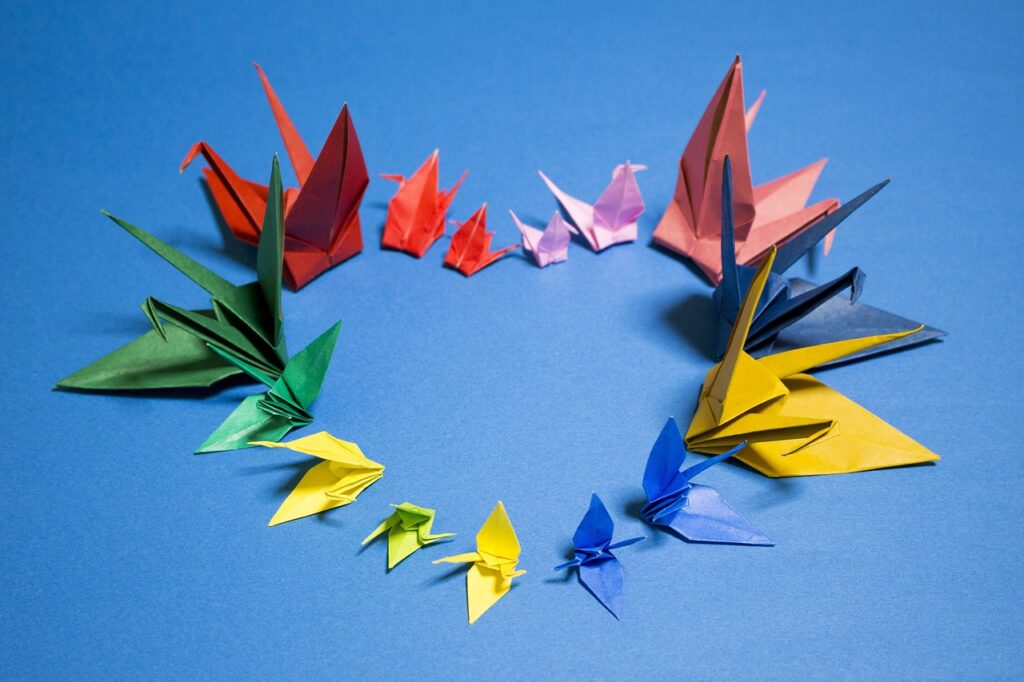Chapter 1: Introduction to origami
“I think there are many people who don’t know about origami, which is an important part of Japanese culture, so I would like to introduce it to you.”Origami is simply an art form made by folding paper, and is known for its simplicity and beauty. This art is a technique of creating various shapes using a single sheet of paper, and is deeply connected to Japanese culture.
Origami is an art that maximizes the possibilities of paper, and its appeal is that it allows you to discover infinite possibilities within its limitations. The basic technique of origami is very simple and anyone can easily learn it. However, hidden within its simplicity is the skill to create complex shapes and designs.
The appeal of origami lies in its accessibility. All you need is paper and a little skill, and yet the creator’s creativity, skill, and sensibility are expressed through origami. Origami is a great way to understand the balance of color, shape and structure, and can also help develop spatial awareness and geometric thinking.
In addition, origami is an art that anyone can enjoy, regardless of age or experience, and is supported by a wide range of people from children to adults. Along with its ease, origami also provides a deep concentration and meditative experience, calming the mind and reducing stress. Folding paper calms your mind and allows you to discover new things and enjoy creative joy.
Origami is also a great way to express Japan’s beautiful nature and seasons. You can use paper in a variety of colors and textures to express the beauty of nature and the changing seasons. For example, you can use origami to express the beauty of Japan’s nature, such as cherry blossoms, autumn leaves, and snowflakes.
Origami is also very effective as a communication and educational tool. Children can develop manual dexterity, creativity, and concentration through origami. Origami is also a great way to communicate with people across language barriers. People from different cultures and backgrounds come together to fold paper and create beautiful works of art with a common purpose, allowing them to understand each other’s cultures and deepen their friendships.
In this way, origami is an art that symbolizes the beauty and depth of Japanese culture, and is loved by many people for its simplicity, depth, and endless possibilities. The world of origami continues to expand, providing many people with an opportunity to feel, understand, and enjoy Japan’s beautiful culture and tradition.

Chapter 2: Historical and cultural background
“I will tell you how origami has developed in Japan up until now, including history and culture.”Origami is deeply connected to Japan’s ancient culture. Its origins are said to date back to the Nara period, about 1,400 years ago, when paper was introduced to Japan from China. Early origami was mainly used in religious ceremonies and festivals, and was especially popular among aristocrats and temples. Origami was considered sacred and played an important role in sacred ceremonies and rituals.
In the Heian period, origami spread further and became part of court culture. Aristocrats experimented with artistic expression through origami, and origami techniques became more sophisticated. During this period, origami became a part of traditional Japanese culture, combining it with other art forms such as literature, poetry, and painting.
In the Edo period, origami spread to a wider range of people and became popular among the common people. During this period, various origami patterns and techniques were developed, and origami textbooks began to be published. Origami has also come to be used as a means of social interaction and education, and is now widely taught to children.
In the modern era, origami became internationally recognized and spread throughout the world as part of Japanese culture. Especially since the mid-20th century, origami has attracted attention in the fields of education and art, and origami classes and exhibitions have been held in many countries. Origami is also related to fields such as mathematics, geometry, and engineering, making it an interesting topic for many researchers and artists.
The history of origami is closely tied to Japanese history and culture, and its development reflects the changes in Japanese society and culture. Origami represents the Japanese aesthetic sensibility and spirituality sought in artistic expression, which is reflected in the simple yet profound beauty of origami. The history of origami allows us to understand the richness and diversity of Japanese culture and society, and origami continues to convey Japan’s beautiful traditions and artistry to people around the world.
Chapter 3: Origami in modern times
“Let me show you what origami is like in modern Japan.” Origami is a beautiful example of traditional Japanese culture being carried on into modern times. Today, origami is still widely loved in the fields of education, art, and entertainment. It is especially popular among children, and is used in many schools and homes as a teaching material that fosters creativity and the fun of using one’s hands.
Modern origami has an extremely wide range of expressions, and has become more than just a technique for folding paper, and is increasingly being regarded as a work of art. Origami artists around the world are expanding the possibilities of origami by developing their own styles and techniques based on Japanese origami techniques. Many origami exhibitions and workshops are held here, and new origami techniques and designs continue to be created.
Origami also plays an important role in the fields of science and engineering. The technique of origami has found a variety of technological applications, including the design of new materials and the structural design of space probes. The geometric properties and mobility of origami are a source of new ideas and solutions, making it an interesting subject of study for many researchers and engineers.
The social impact of origami cannot be ignored either. Origami is also used as a means of communication, creating opportunities for people to come together and deepen interactions through origami. In particular, the origami community is inclusive in nature, providing a place for people to participate, learn, and create together, regardless of age, nationality, or language.
The aesthetics and philosophy of origami are also finding new meaning in modern times. Origami is simple yet deeply expressive, providing quiet yet powerful beauty in everyday life. It has something in common with the Japanese aesthetic of “wabi-sabi,” and the endless possibilities that arise from a single piece of origami paper are a source of spiritual enrichment and creativity in today’s busy lives. Origami continues to exist in modern society as a valuable artistic and educational resource, and as a small joy in daily life.

Chapter 4: Famous works featuring origami
“Here are some of the most famous works featuring origami.” Origami has inspired many artists, writers, and filmmakers due to its beauty and unique techniques. This chapter introduces some famous works with origami as a theme or created using origami.
Movie “Kubo and the Two Strings”: This animated film follows the adventures of Kubo, a boy who uses origami to tell stories. In the film, origami is used as a fascinating visual effect to tell a beautiful story that celebrates traditional Japanese culture.
Artist Eric Joisel: Eric Joisel is internationally known as an origami artist. His works use traditional origami techniques to create highly original and detailed figures and animals. Joiselle’s origami creations have been exhibited in galleries around the world and are examples of origami’s artistic potential.
Origami artist Robert J. Lang: Robert J. Lang is known for his work that combines origami techniques and mathematics. He uses origami techniques to create highly complex and beautiful creatures and structures that exemplify the technological advancement of origami.
Book “The Science of Origami”: This book explores the relationship between origami techniques and mathematics, elucidating the geometric aspects of origami. It shows that origami can help develop mathematical thinking and geometric understanding, and reveals the connection between origami and science.
Origami art exhibitions: Many museums and galleries around the world have origami art exhibitions. These exhibits broadly showcase the beauty and diversity of origami and showcase new origami techniques and designs. These exhibitions prove that origami is not just a child’s play, but a cultural heritage with deep artistic expression.
As mentioned above, origami has been praised for its beauty and originality by many famous works and artists, and has been expressed in various forms. These works expand the possibilities of origami and demonstrate the artistic and educational value of origami to people around the world.
Chapter 5: Summary
“This is a summary about origami.” Origami, a traditional Japanese art, begins with a single piece of paper and offers us endless possibilities and creativity. This simple yet profound art form is closely tied to Japanese culture and history and is loved by many people. Origami is familiar to a wide range of people, from children to adults, and also plays an important role in education. Additionally, origami is also closely related to science and mathematics, contributing to new technological advances and discoveries.
Origami has inspired many artists, writers, and filmmakers due to its beauty and unique technique. In addition, many famous works and origami art exhibitions on the theme of origami widely convey the artistic and educational value of origami. Additionally, the technique of origami has influenced the development of new designs and techniques.
Origami is becoming increasingly popular not only in Japan but around the world, and there are many origami communities and clubs. These communities work to learn origami techniques, share new designs, and spread the joy of origami. Origami offers the joy of art and creativity to many people due to its accessibility and versatility.
Ultimately, origami is an example of Japan’s beautiful culture, introducing Japanese traditions and art to people all over the world. Origami forms an important part of Japanese culture through its unique beauty, simplicity, and endless possibilities. And through origami, each of us can explore creativity, learn new things, and create beautiful works. The world of origami continues to expand and will continue to bring richness and joy to our lives.
